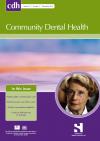Community Dental Health

- Cover Date:
- December 2015
- Vol:
- 32
- Issue:
- 4
Patient safety in domiciliary dental care for elderly nursing home residents in Sweden
Objective: To analyse patient safety in domiciliary dental care, with data from a quality registry. Design: Retrospective analysis. Clinical
setting: Domiciliary dental care, private caregiver, Sweden, 2012-2014. Methods: All reported events in the quality registry at a provider of
domiciliary dental care, (2012-05-01 to 2014-06-30) were categorized into 14 domains, and for severity as ‘minor’, ‘moderate’, or ‘serious’
events. The reported events were also independently assessed by an experienced reviewer for national requirements of reporting patient
safety related events. Results: The quality registry covered 724 (0.03%) reported events during 218,586 consecutive treatment sessions in
domiciliary dental care, including 628,070 registered dental procedures. Fifty (6.9%) of the reported events were patient safety related, of
which 11 (1.5%) events were reportedly of minor severity, 20 (2.8%) as moderate, and 19 (2.6%) as serious. For all degrees of severity,
the most frequently reported events were related to problems with patient identity control (3.3%). None of the events required reporting to
national authorities. Conclusions: Domiciliary dental care has a low frequency of patient safety related events (0.03% of all treatments).
Identity controls need to be emphasised in nursing homes or where individuals are dependent on the care of others.
Key words: aged, dentistry, domiciliary care, geriatric dentistry, patient safety, nursing homes, Sweden
- Article Price
- £15.00
- Institution Article Price
- £
- Page Start
- 216
- Page End
- 220
- Authors
- P. Sjögren, N. Bäckman, O. Sjöström, M. Zimmerman
Articles from this issue
- Title
- Pg. Start
- Pg. End
- The feasibility of using an alcohol screening tool in a UK dental setting to identify patients’ alcohol consumption
- 196
- 198
- Long term evaluation of the clinical effectiveness of community milk fluoridation in Bulgaria
- 199
- 203
- Time trends and determinants of acute odontogenic maxillofacial infections in Lithuania: a retrospective national 2009-2013 treatment data audit
- 209
- 215
- Dental anxiety and oral health in 15-year-olds: a repeated cross-sectional study over 30 years
- 221
- 225
- Development and evaluation of a Dental Patient Feedback on Consultation skills (DPFC) measure to enhance communication
- 226
- 230
- A retrospective audit of population service access trends for cleft lip and cleft palate patients
- 237
- 240
- Caregiver financial distress, depressive symptoms and limited social capital as barriers to children’s dental care in a midwestern county in the United States
- 252
- 256
